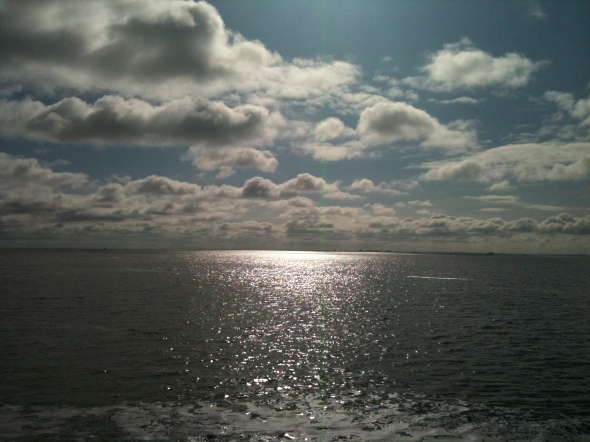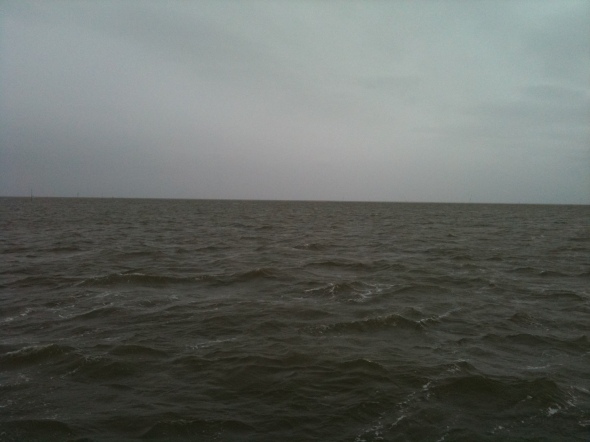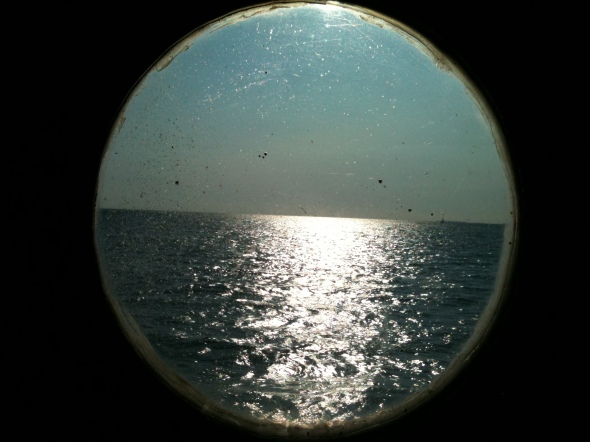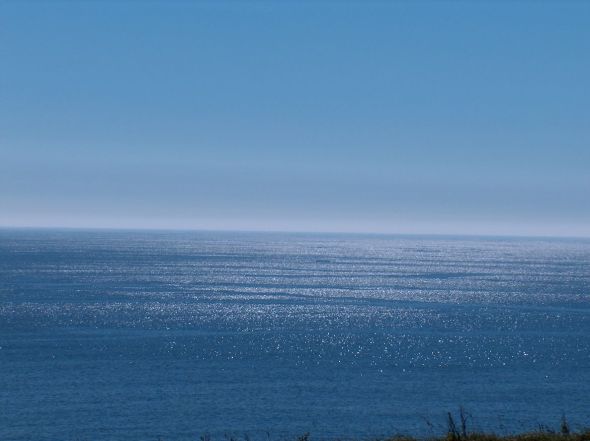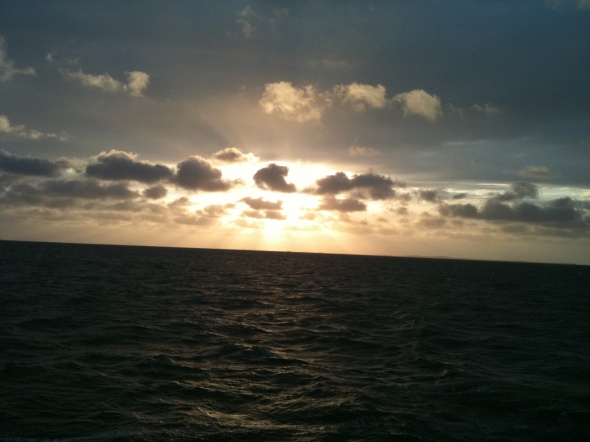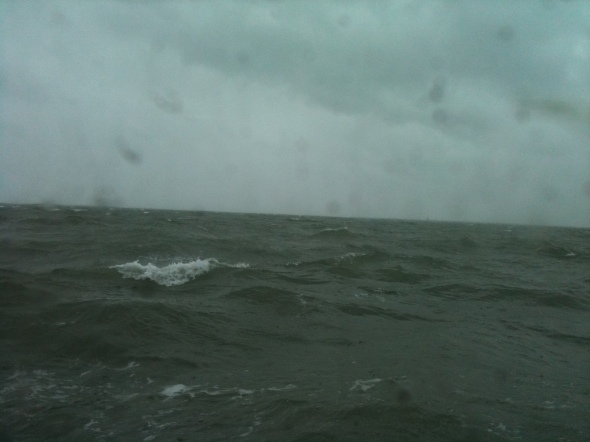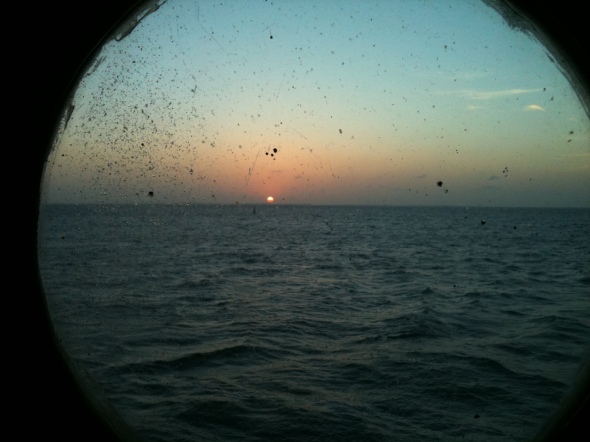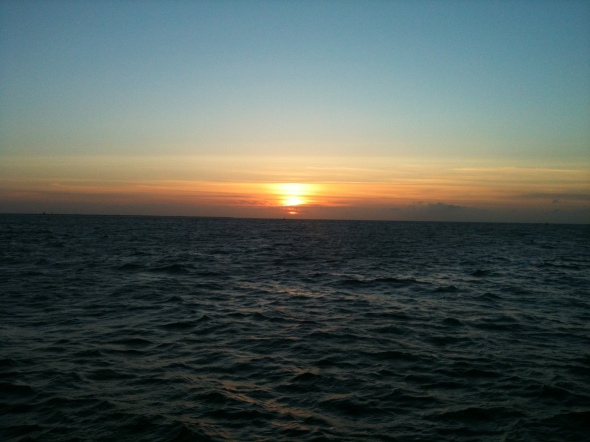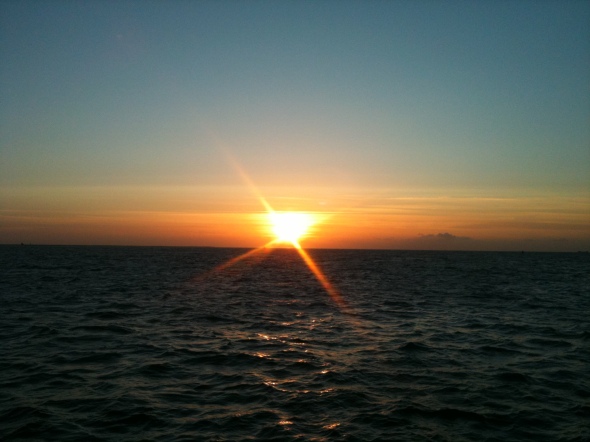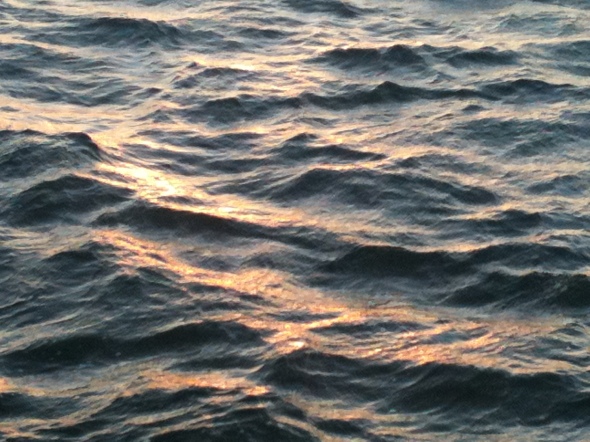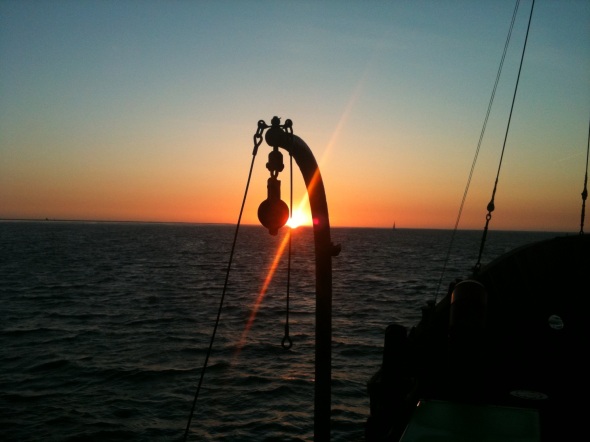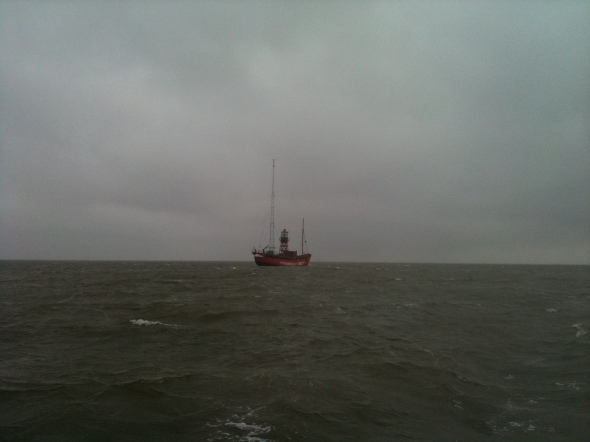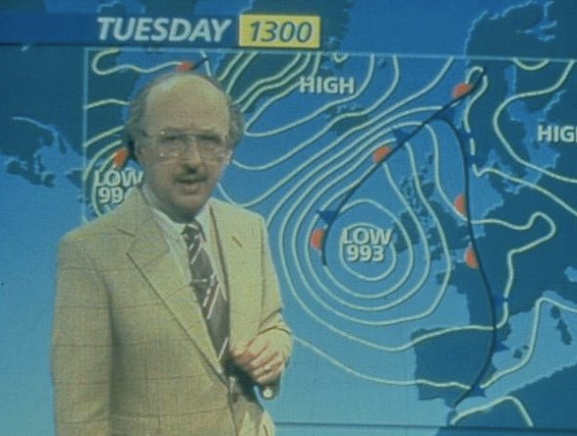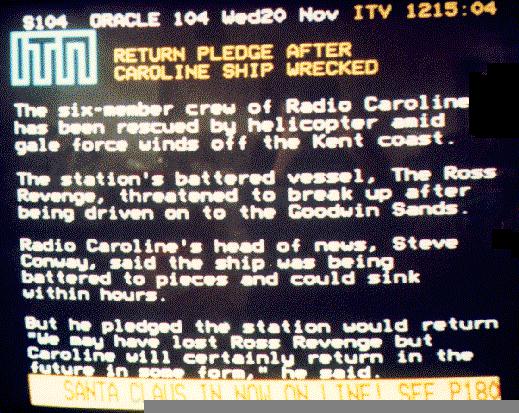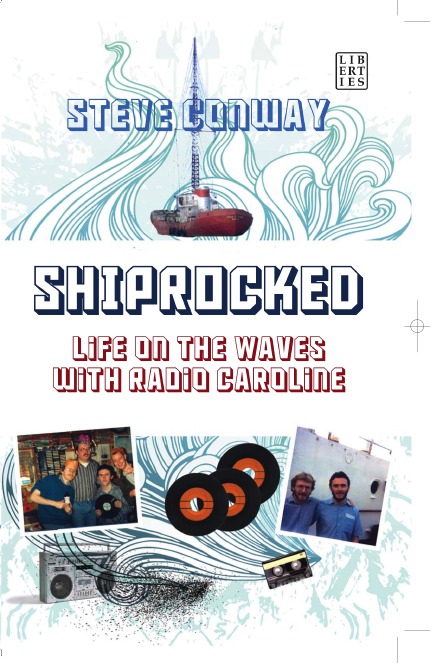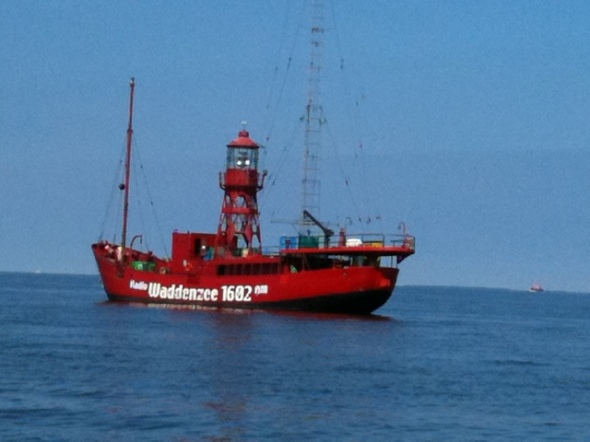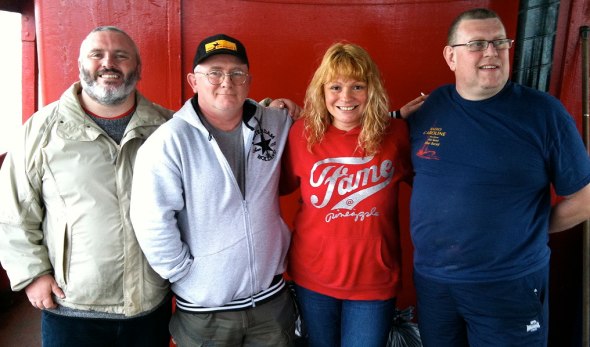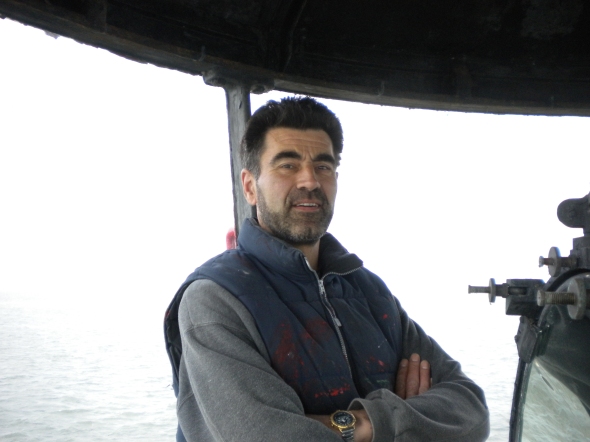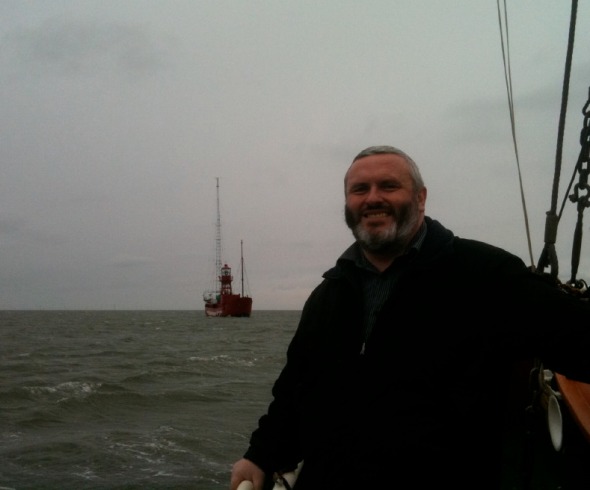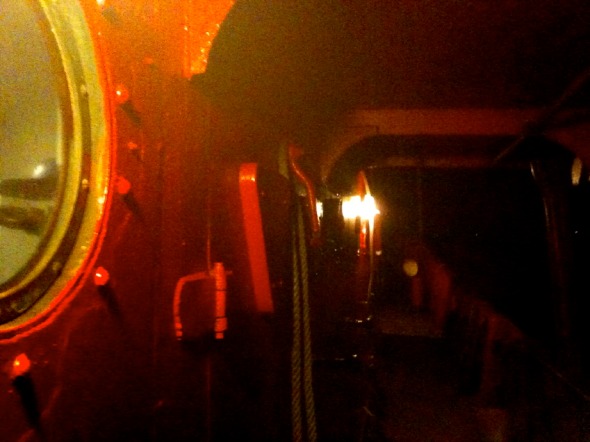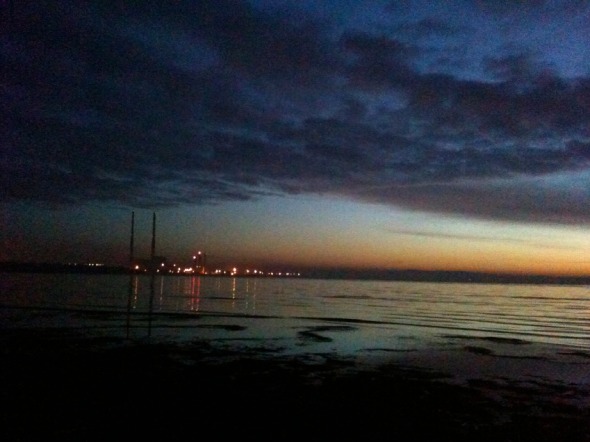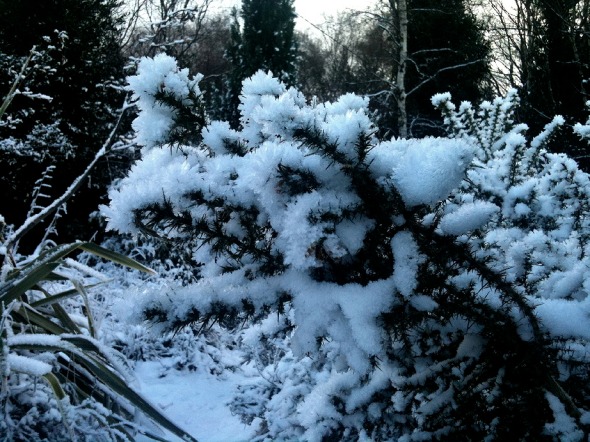Shiprocked – New Edition launched in Dublin
Posted: January 16, 2015 Filed under: 1980s, 1987, Irish writing, New writing, Newsreading, non-Fiction, offshore, Radio Caroline, Radio presenting, Ross Revenge, Shiprocked!, storms at sea | Tags: books, Irish writing, radio, Radio Caroline, Shiprocked! 1 CommentThe new (2014) edition of Shiprocked – Life On The Waves With Radio Caroline was launched in Dublin last night, with former Caroline and RTE 2FM broadcaster, and current-day drive time 4FM presenter Gareth O’Callaghan doing the honours.
The book is already in stock at most large retailers in Ireland, and will be on sale in the UK shortly.
Below are some pictures from the launch event, in which selected extracts from the text were presented alongside archive TV news footage and of-air audio to give a flavour of 1980s Caroline for the 100 strong crowd who turned out at The Odessa Club for the occasion.
Big thanks to Johnny Bambury for this excellent series of shots.

Gareth told the audience how much he enjoyed reading Shiprocked (twice!) and also spoke of his own fond memories of working on board Radio Caroline

A number of former Caroline staffers were present for the launch, including Caroline North engineer Michael and his daughter Sue (Michael centre in shot) and former Caroline newsreader turned music journalist Stuart Clarke (right)
.
Pictures of Empty Sea
Posted: January 11, 2013 Filed under: Life, Most Requested, offshore, radio, Radio Caroline, Radio Seagull, Ross Revenge, Sea Photos, Ships, storms at sea | Tags: Empty Sea, Most Requested, offshore, Offshore Radio, Photography, photos, sea, sea photos 2 Commentsto view the wholly perfect horizon around you in full 360 degrees, nothing but water as far as you can see, with your own self at the perfect centre of it
This set of photos comes to you by request – your request.
Every week, sometimes as often as every day, a particular phrase pop up in my search referrer logs (the bit in my stats which tells me what people were searching for on Google or other search engines which led them to click through to this site).
“pictures of empty sea” or sometimes just “empty sea”
Several people a week, over the last three years, a steady stream from around the world, adds up to quite a few views over the years, and all looking for empty sea.
This blog is actually the first result presented on Google for “images of empty sea” and the second for the text phrase “empty sea”.
This all stems from a post I wrote almost five years ago, talking about a particular scene in a book I had just completed writing, then known as “Somewhere Down The Crazy River” but since published as “Shiprocked – Life On The Waves With Radio Caroline”.
The post contained a shot of the view from the Caroline ship – nothing but the horizon and empty sea. And it’s that picture which has brought people here. But since so many people come to look for it, and the sea is, and always has been, my lover, I’ve decided to share a few more of the intimate pictures taken during our many trysts.
As always, you can click on any picture for a bigger version. All pictures taken of the North Sea (or its daughter the Waddenzzee ) off the English and Dutch coasts, unless otherwise specified, during my stints on Radio Caroline and Radio Seagull.
When I went to work on the offshore radio ships, people kept asking if life was boring. After all, the sea was the sea, and was always the same they reasoned.
Boring? When the view through the porthole is never the same two days in a row? The sea is a mistress of infinite moods.
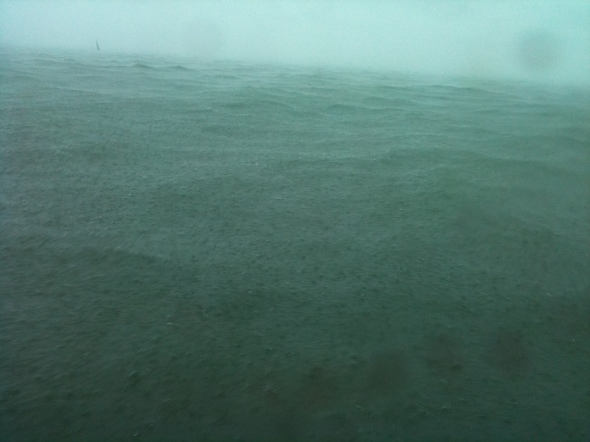
The almost dreamlike quality of the sea pounded and smoothed by a torrential downpour – photographed through a porthole at eye-level to my bunk – what a gorgeous way to wake up!
So, those are the “empty sea photos.
Below I include a couple more, where the sea is not quite empty, but which I feel are similarly beautiful.
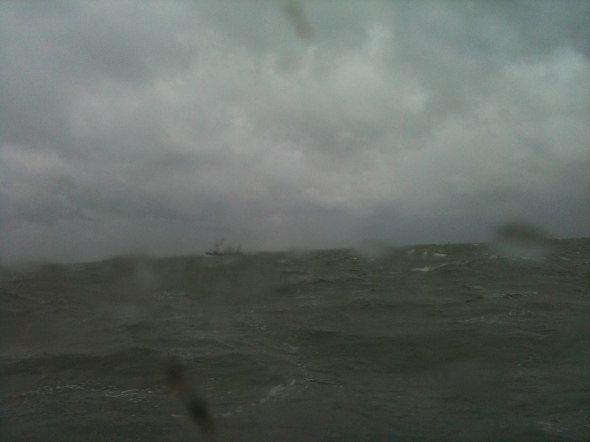
For some reason this photo brings back the most intense memories of the “feel” of being at sea – grey skies, moderate sea, and a fishing boat just glimpsed through a spray-streaked porthole. I can almost hear the wind moaning in the superstructure . .
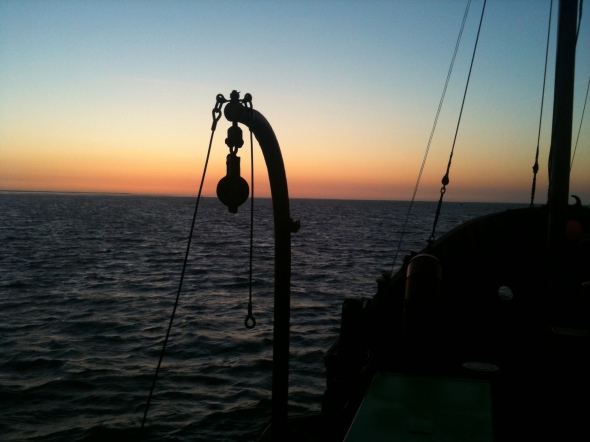
4.55AM, I’ve been on watch overnight, and am just about to make another round of the ship and check anchor chain in the pre-dawn light.
Wonderful experiences and a great life. The radio was exciting, but the sea was always breathtaking.
Always my lover, I’m not sure if I possess her soul, or she mine.
I hope you enjoyed these as much as I did.
Steve
Hissing In The Wind (or: They Will Never Listen)
Posted: October 15, 2012 Filed under: 1987, Radio Caroline, Ross Revenge, Shiprocked!, Ships, storms at sea, Weather | Tags: 1987 Hurricane, BBC, Great Storm Of 1987, Kent, Michael Fish, Pirate Radio, Popular Myths, Shiprocked!, Ships, UK, UK Met Office, Weather 1 CommentThe above photo needs no introduction.
You know the spiel by now.
25 years ago today/tomorrow, the night of the 15th/16th October 1987 saw The Great Storm, or The 1987 Hurricane, or whatever you would like to call it. Millions of trees uprooted, millions in property damage, 18 people killed, road, rail and power disrupted, and none of it forseen or foretold by the met office.
Amid great sniggering, the clip of Michael Fish reading the weather forecast on BBC TV at lunchtime on the 15th will be played, with him saying there is no hurricane coming, and the talk will be of how utterly the Met Office failed to prepare the Great British Public for the terrible storm.
That’s the collective memory, and everyone knows it is true.
Except . . it isn’t.
I was there, and I was right in the teeth of the storm in all it’s fury, and I had been watching that lunchtime weather forecast, and I had heard Michael follow his comment about there not being a hurricane (technically true) by telling everyone that there was going to be some very stormy weather overnight. Ah, but they never play that bit of the clip do they?
But more than that, I was expecting him to say this, and I knew several days earlier that the morning of the 16th would see a great and violent storm coming in from the southwest . . because the Met Office had told me, and other BBC viewers. Far from being unprepared, we were well prepared for a storm, and although, yes, it was much more severe than we expected, it is wholly unfair to say that the nation was not warned.
The nation was, you see, mostly indifferent to the weather warnings over the preceeding days, and much more concerned with waiting for Neighbours to come on after the news bulletin. But the warning was there, as far back as the previous Sunday.
I should clarify here that myself and my colleagues on board Radio Caroline were always very attentive to the weather, and always watchful and mindful of what it was going to do, as in our exposed anchorage 18 miles off the Kent coast the weather had a profound impact on our day to day life – on our level of comfort, on the ease of our doing our jobs, on our prospects of being resupplied at any given time, and on the quality of our sleep. So we were very attentive and invested in the weather forecasts.
You might expect me to tell you of the amazing struggles to stay on the air during the great storm, and the frightening moments and waves as tall as buildings that we encountered that day, but that is not the purpose of this article. I’ve written about it in my book Shiprocked – Life On The Waves With Radio Caroline, and there is another account of it written by myself, which you can read for free online at Soundscapes (EDIT: for some reason the article cannot be directly linked from here, but if you google “soundscapes conway hurricane” you will find it)..
No, this piece is my attempt to shout my truth unheeded into the wind yet one more time, and try to tell you that the story of Michael Fish and the sleeping Met Office is . . just a story, a popular narrative.
Unfortunately, it has over time become THE Story, the only one that is told.
So, did the Met Office warn about the storm, and how far in advance did we know?
We knew as far back as Sunday 11th October, four or five days earlier, that we were in for an almighty storm in the early hours of Friday 16th.
Needing to be conscious of the weather, and as Caroline’s Head of News, one of the things I never missed was the Farming Programme on Sundays on BBC1 (not sure if it was called Countryfile back then, but it was essentially a more down to earth and less jazzy version of the programme that still runs to this day). The programme always featured a long-range weather forecast for the next 7 days, and this was highly useful to us on Caroline for assessing if we were going to have some bumpy days, and when there might be a weather window for supply boats to reach us.
I was particularly conscious of the forecast on that particular Sunday, as we were short staffed (two presenters down), running short on certain supplies, and crucially had not received new records for a number of weeks (pretty essential for a contemporary music station). The large supply ship that came out from France that weekend did not have these people or items, but brought a message with it that there would be a small boat coming from the UK on Friday with fresh staff, supplies, and music.
Looking at the long-range weather forecast on the farming programme, we knew that this was just a pipe dream, and that there would be no new supplies on Friday – the weather would be far too rough for even the much bigger French tender to come to us, never mind a small fishing boat.
So although the ferocity of those mountainous seas at daybreak on Friday, 25 years ago, did astonish us, we could not, truly, say we were not warned.
Next time you see the clip of Michael Fish, and you hear the story about how forecasters did not predict a storm, don’t believe it.
I’d like to believe that my personal truth would counter the popular myth, but i know that, like on that morning a quarter of a century ago, my words will be lost in the howling wind.
Steve
Facing Death At Dawn . . And Life Afterwards
Posted: November 20, 2011 Filed under: 10 Things, broadcast engineering, Early Phantom, non-Fiction, offshore, Phantom 105.2, radio, Radio Caroline, Ross Revenge, Shiprocked!, Ships, storms at sea, Technology, Weather | Tags: Change, Goodwin Sands, International Waters, life, Life Changing Experiences, Pirate Radio, radio, Radio Caroline, Rescue, Storms, Survivor, UK, Weather 3 Comments
The past is indeed another country, but the future is a map that we can draw for ourselves if we dare.
It was 20 years ago this morning, (20th November 1991) that I came to the end of the roughest night I had ever known in all my years at sea with Radio Caroline, and faced what I came to believe would be my last ever dawn.
Aground on the infamous Goodwin Sands, which have claimed hundreds of ships and thousands of lives, we were gradually rolling over, each wave pushing us a little closer to the tipping point where the ship would capsize. Ironically, although there was not enough water to float her, there was more than enough to flood into her and fill her up if we went sideways . . more than enough to drown in.
The waves were towering in the North Easterly Force 11 winds, the seas icy – we wouldn’t have lasted more than a few minutes if we went over.
The brave men of Ramsgate Lifeboat had already tried to rescue us and failed, running aground themselves, losing a man overboard in the process (happily quickly recovered by safety line). Now we were waiting for the helicopter, but it seemed we would be in the water before it arrived . .
Certain that we would be drowning in minutes, the floor beneath us already at a 45 degree angle, we hugged each other, shook hands, and said goodbye. We knew we were going to our doom . .
The story of that morning, and our eventual rescue by the RAF helicopter R166 is described in detail in my book Shiprocked – Life On The Waves With Radio Caroline, but even the printed word cannot do justice to the memories which are still vividly seared onto my brain, even all these years later.
I absolutely believed that I was about to die, and that morning, and in particular that moment, has changed my life since then.
The 20 years I have lived since that morning on the Goodwins is a bonus, and the older I have got, the more I have appreciated this, and the more I have lived my life with zeast and purpose. The sudden seeming end of Caroline in 1991 (though not the final end, as it has bounced back and is adpating to a new age) instilled in me a knowledge of the impermanance of states of being, and ensured that when I got involved with Phantom FM in later years I treasured each moment, and drove myself to both give and take the maximum from every day that I worked there.
In life too, I reach out with lust for living to take the most from each day, and push myself to do and experience more and newer things.
Life is a bonus, and I am determined to spend that bonus to the full.
Many people around me comment on my seemingly unflappable calm when faced with difficult situations. This too comes from that morning on the Goodwins, for as I see it, I have been minutes from an icy drowning death, so why should anything that happens in a more normal work or life based situation cause me to panic?
Time has been kind to Radio Caroline too, and that morning, seemingly a point of closure for the station was to be in fact the first step in forcing it to adapt to a new path, which though seemingly bleak for much of the 1990s, has blossomed in latter years into an unprecedented period of stable broadcasts, with new technology enabling the station to be heard in undreamed of quality in previously unreachable countries.
20 years on I have spent the night of the 19th/20th November sipping wine with close friends, and thanking my lucky stars for all the richness of life and the benefits of new technology that both I and Radio Caroline have enjoyed in the last 20 years.
It’s right to raise a glass and look back, but the biggest gift of all is to be able to raise my gaze and look forwards.
Steve
Special Reading & Talk to commemorate 20 Years Since The Goodwins Shipwreck
Posted: November 13, 2011 Filed under: Events, offshore, Radio Caroline, Ross Revenge, Seven Towers, Shiprocked!, storms at sea | Tags: Dublin, East Wall, Events, Goodwin Sands, Pirate Radio, Radio Caroline, Reading, Shiprocked! Leave a comment20 years on from the most terrifying morning of my life . . aground on the Goodwin Sands with hopes of rescue seemingly dashed as the crew of the Ross Revenge shook hands and prepared for the ship to roll over . . .
Seven Towers Agency, East Wall for All and The Sean O’Casey Community Centre present:
Radio Caroline, former Phantom FM DJ and Best Selling Author
Steve Conway
Reading from his book
Shiprocked, Life on the Waves With Radio Caroline
Sean O’Casey Community Centre, East Wall, Dublin.
7pm Monday 21 November
free parking, admission free
20 Years ago this November, Dubliner and East Wall resident Steve Conway survived the shipwreck of the Ross Revenge, the last of the Radio Caroline off-shore Radio Ships. Reading from his book, Shiprocked he tells of this event and of his life on the famous Pirate Station, Radio Caroline.
Steve will also read a preview excerpt from his new book, due out next year, that covers his career beyond Caroline, including the 10 years spent working for Dublin’s alternative station Phantom FM / Phantom 105.2
This event is free, but an opportunity will be available to give donations and to RNLI and Sean O’Casey Community Centre.
So Who Are Radio Seagull?
Posted: October 24, 2011 Filed under: broadcast engineering, Classic Rock, Music, New Music, offshore, Radio presenting, Radio Seagull, Ships, storms at sea, Weather | Tags: Music Radio, Offshore Radio, radio, Radio Seagull, Ships, The Netherlands, Transmitters, Waddenzee 1 CommentThe recent test-transmissions on 1395Khz by Radio Seagull have driven quite a few Google search requests to this blog, so I’ve decided to give a quick run-down on the station for any new visitors, as well as for those who follow me for my other content and might be curious.
Please note my disclaimer: I am a Radio Seagull presenter myself (Saturdays 7-9am and pm CET, 6-8am and pm UK/Irish time) so you are reading an insider rather than an outsiders point of view. Having said that, I also have to point out that all views are my own, and not neccessarily endorsed by the station.
So, what is Radio Seagull?
Radio Seagull is a full-time, permanent, licenced terrestrial, English-language radio station based in The Netherlands, specifically the town of Harlingen, in the northern coastal area. As well as AM coverage emenating from Harlingen, the station can be heard worldwide via its online stream, accessible from the station website – www.radioseagull.com
How can I hear Radio Seagull?
In The Netherlands the station shares its AM frequency (1602Khz) with Radio Waddenzee, a regional station servicing the north of The Netherlands in the Dutch language. Waddenzee is heard from 7am-7pm and Seagull from 7pm to 7am on mediumwave, however Seagull is available 24 hours a day online.
(Radio Waddenzee takes its name from The Wadden Zee, a large area of sea on the fringe of the North Sea, but partly protected by a chain of islands 20km or so from the coast.)
As well as terrestrial and online outlets, Radio Seagull is sometimes carried as a sustaining service on other stations around the world. Currently the station is being relayed as the content of a series of test transmissions on 1395Khz on AM, which are being made from the Radio Seagull ship, the Jenni Baynton. These are scheduled to continue until mid-November (but Seagull will continue to be available on its permanent frequency of 1602Khz, at all times).
What type of programmes does Radio Seagull have?
Radio Seagull features both modern alternative and classic rock, as well as a wide variety of specialist music shows. Some presenters specialise in new and alternative music, others present more general shows. Details can be found at the website www.radioseagull.com.
In order to cater for international listeners in different time-zones, the schedule is organised into groups of programmes in 12-hour blocks, repeated once the same day – so that, for example, a show aired at 3-5pm will also be aired at 3-5am, giving people in different parts of the world the chance to hear each show in their “daytime”.
How is Radio Seagull different from other stations I can hear on the internet, or local stations on FM?
Radio Seagull’s programming philosophy is to gather together experienced and professional presenters from around the world, people who are passionate about the music they play, or very knowledgeable in their specialist area, and to give them complete creative freedom to produce the best shows that they can. Unlike larger commercial radio stations, there is no restriction on playlist size, and as a result the music you hear on air is incredibly diverse and wide-ranging.
Presenters come from all across Europe and further afield to work on Seagull, and many are people who have been involved in radio for a long time.
So what’s all this about a ship?
Radio Seagull (and its sister station Radio Waddenzee) are housed on board a former British Lightship (LV8), the Jenni Baynton, which is normally berthed in the harbour at Harlingen. The ship itself is an attraction, bursting full of history, and much restored since its acquisition by Seagull in the early 2000s, and it makes a wonderful base for the radio station – lots of room for studios, engineering facilities, radio mast, and cabins where crew and visiting DJs can be accomodated during special offshore broadcasts. The station also has landbased transmission facilities.
But the ship is more than just a static base.
Once a year, for the last several years, the station has put to sea for periods of about a month each summer, with crew and DJs living on board, a great opportunity for friendships to be rekindled and knowledge to be swapped, as well as recreating some of the excitement of the old offshore radio days (a number of the Seagull presenters, myself included, are veterans of the former offshore pirate stations such as Radio Caroline).
Who is behind Radio Seagull?
Seagull is the brainchild of Sietse Brouwer, a Dutch businessman and radio presenter who also spent some time working with Radio Caroline in the 1990s. Sietse has a passion for good radio, and a great love of ships, and putting the two together in his home town of Harlingen has occupied a great part of his time for the last 10 years.
Where can I get more info / how can I listen?
The best place to start for both is the website – www.radioseagull.com
You can also see more of my pictures from Radio Seagull’s offshore adventures at the following pages:
https://steveconway.wordpress.com/seagull/the-jenni-baynton-at-sea/
https://steveconway.wordpress.com/seagull/inside-the-jenni-baynton/
https://steveconway.wordpress.com/seagull/jenni-baynton-crew/
https://steveconway.wordpress.com/2011/06/07/dreamy-seagull-pics/
If you are a new visitor, I hope this has answered your questions, and made you curious enough to listen.
I can be heard every Saturday 7-9am and pm CET, (6-8am and pm UK/Irish time).
But don’t just listen to me – the rest of the presenters are superb!
Steve
In 2010, I Lived.
Posted: December 31, 2010 Filed under: 10 Things, 1980s, Dublin photos, Fiction, Irish writing, Love, Music, New Music, New writing, non-Fiction, Odd photos, offshore, Phantom 105.2, Prose, radio, Radio Caroline, Radio presenting, Radio Seagull, Ross Revenge, Sex, Shiprocked!, Ships, storms at sea, Weather | Tags: 2010, Bristol, Dublin Airport, emotion, Growth, Hot Air Balloon, Music, Offshore Radio, Opera, Radio Caroline, Radio Seagull, review, RNLI, Sunrise, Sunset 2 Comments
- Looking back . . the sun and all that is Dublin can be seen from the very tip of the Great South Wall in the centre of Dublin Bay
Looking back, I can’t recall another year in my life when I have lived as vividly as I did in 2010.
Despite 2010 being bleak economically and politically both home in Ireland and pretty much everywhere else in the west, despite long hours and stress in various workplaces, despite some non-threatening but quite inconveniencing medical blips, despite my car heater dying just in time for the coldest December since records began . . 2010 was a year in which I really lived, in which old emotions were reawakened, and new ones discovered, and my store of life experience grew more than it has done in a long time.
I had set myself a challenge at the end of 2009 to start doing things I had never done before, to open myself to new experiences beyond my comfort zone. And while I didn’t get to the arbitrary goal of “10 things” during the year, I reached 5, two of which were experiences that profoundly moved or enriched me, and a third which brought back childhood memories entwined in a futuristic setting.
Not all of the great things that happened to me during the year were as a result of this self-challenge, but perhaps the attitude it engendered in me of being more open filtered through to other things too.
So what made my year?
Well, some unique experiences came about as i sought to push myself into new things.
Taking part in the Bristol Balloon Fiesta was certainly a “high” point of the year, and my first ever hot-air balloon flight, as part of a mass ascent of more than 80 balloons within an hour at dawn, was a unique and moving experience, so much so that I felt to write about it in purely descriptive journalistic terms would be . . to miss some indefinable element of the experience.
Twisting it in my mind, it instead inspired me to write a short story “A Bristol Awakening” that is neither fact nor fiction, but also both. A very intimate story, it has been received well at a number of public readings, especially by women, and I am hoping to see it published in 2011.

Launching from a Bristol hillside at dwan, with ballons of every shape and size coming before and after us

Drifting lazily and silently through the sky over Bristol, with the Avon Gorge, the Bristol Channel and Wales visible in the distance
Slightly more down to earth, though involving a different sort of (non) flying, as one of my challenges I put myself forward to the Dublin Airport Authority to be one of the special testers of the new Terminal 2 before it opened. Apart from fulfilling my curiosity about the new building, and allowing me a sneak peek at new transport infrastructure, which I’ve always been interested in, the experience reminded me of aspects of my past that I had long forgotten, and also gave me a chance to get my own back on customs, just for once. You can read the details in my post Mr. Beagle Goes To London (Not).
Something I have never wanted to do, and felt I would always avoid, enriched my life and gave me a wonderful experience when i tried it as part of the “going outside my comfort zone” element of my 10-things challenge. A visit to the Royal Opera House in Covent Garden, accompanied by a an impossibly glamourous companion, opened a whole new world of experience, sight, sound, and stimulation to me. I enjoyed it more than I could possibly have imagined, and do intend to write up the experience here at a later date.
Pushing myself outside my comfort zone, doing what I would not normally consider doing was one of the elements i wanted to achieve in drawing up my list of 10 things, and I am so very glad I did this.
As the year comes to an end, I’ve so far ticked off 5 things, and have more still in planning, with some space left on the list for spontenaity.
So 2011 should continue in similar vein, and to be honest, when I reach 10, why stop there?
Of course, there were other things which made 2010 an exceptional year for me, some planned, others unexpected.
A couple of things that really moved me were radio related, and did not come about as a result of my challenge list.
Going in March to Ramsgate to do a reading from Shiprocked for the benefit of the RNLI, brought me face to face with the men who came to my rescue on one of the darkest days of my life, 19 years earlier.
Meeting the crew of the lifeboat who battled through a Force 10 NE to come to our aid when the Caroline ship was aground on the Goodwin Sands was a profoundly humbling experience, all the more so because of the warmth of the welcome I received, and the support they showed for Caroline despite having been put through hell that morning and nearly losing their own lives on account of our stubborn decision to stay on board the apparently doomed vessel.
I won’t forget the men of the Ramsgate Lifeboat, and will be making another fundraising trip to see them in November 2011, on the 20th anniversary of the grounding.
The same weekend I revisited the Ross Revenge for the first time in many years, and was invited to join the current-day lineup of Caroline on satellite, which, despite the many years of my absence, felt like a real homecoming.
(I can be heard on Caroline every Monday 2-4pm, Sky Digital Ch.0199 and via RadioCaroline.co.uk )
Another emotional moment came about in May, after I had been invited to join the crew of the Dutch station Radio Seagull, which was celebrating a month long offshore broadcast, 8 miles of the coast of Friesland.
There were many memories stirred by being offshore for the first time since 1991, though the most intense of these was to come on me unexpectedly.
The week I spent at sea with Radio Seagull was bliss, with old memories awoken, and new friends and new memories made at every moment of each day. (See the posts OFFSHORE AGAIN and Seagull Day 1 and More Seagull Pictures and Clear White Light and A Ferry Large Tender as well as Seagull Offshore – The Pictures for the week as I blogged it at the time)
But the most vivid experience of that week came for me, unexpectedly, in the middle of the night and alone, and had nothing to do with the radio side of the visit. Being given the job of staying up on watch overnight for one of the nights, while usually regarded a something of a chore, for me brought both fear and redemption, as I was finally able to lay to rest the ghosts of what had happened on the Caroline ship, many years earlier, when we drifted, unheeding, onto the deadly Goodwin Sands.
For all that the storm in 1991 had been so fierce, and our ship so run down and unable to navigate that we could not have resisted being swept onto the Goodwin Sands even if we had realised earlier that our anchor chain had broken, I had carried with me these many years a nagging sliver guilt that I should have known, should have been more alert, should have done better.
Now, here I was again, and for the first time since that fateful night, entrusted to watch over a ship at anchor at sea, and in the grips of bad weather too. I was both siezed with fear that it would all go terribly wrong on my watch, and grateful for the chance to prove myself dilligent and keep the most careful of watches. I checked our position regularly, I did a full round of the ship and checked the anchoring cables every hour, I saw us safely through to dawn, and I slayed a dragon that had slumbered in a corner of my mind for many years.
The week was over too soon, but I was delighted to be asked to join the staff of Radio Seagull and to contribute a weekly show from my own studio in Dublin, with my own choice of music – a mix of new and alternative music as well as classic rock, with a bit of blues and soul mixed in. Presenting these shows on Seagull have been an immensely satisfying experience for me.
(I can be heard 7-9 am and pm each Saturday, on 1602Khz MW in The Netherlands, and worldwide at RadioSeagull.com )
Phantom 105.2 in Dublin also continued to be a source of great enjoyment for me, and though I had to move away from regular weekend shows towards the end of the year due to domestic commitments, the station and its staff still feels like an extended family for me, and keeps me informed on new music trends.
There were lots of mini high points in 2010 – from an unexpectedly beautiful sunrise encountered one morning on my way to work, to, finally after all my years on this earth, a proper White Christmas.
There was also another experience, quite unexpected, which made me feel like a teenager again, one unremarkable Saturday afternoon at a railway station in an unremarkable British city . . but I won’t go into that one here!
Suffice to say that, for me at least, 2010 has been a year in which i started living and growing anew, despite being at an age where comfort and stagnation would be more usual.
May 2011 have more of the same . . and new . . for me . . and you.
Happy New Year
Steve Conway
Last Wednesday: Shipwrecked
Posted: September 23, 2008 Filed under: Events, Fiction, Irish writing, New writing, non-Fiction, offshore, Poetry, Prose, Publishing, radio, Radio Caroline, Ross Revenge, Seven Towers, Somewhere Down The Crazy River, storms at sea | Tags: books, Goodwin Sands, Irish writing, New writing, offshore, radio, Radio Caroline, RTE, storms at sea 1 CommentIt’s that time again – the monthly “Last Wednesday” open-mic evening for Irish writers, is on tomorrow, Wednesday 24th September 2008, at Cassidy’s of Westmorland Street in Dublin City Centre.
The event is hosted by the Seven Towers Agency and includes poetry, fiction and nonfiction writing.
Apart from myself, readers will include Doog Wood, Oran Ryan, Eamonn Lynskey, Noel Ó Briain, Donal Moloney and Ross Hattaway.
Ross Hattaway was born in Wellington New Zealand, but has lived in Ireland since 1990. He has had many varied jobs and currently works as a civil servant. His first collection of poetry, The Gentle Art of Rotting was published by Seven Towers in 2006. This will be Ross’ first reading in Dublin, after touring Lithuania as part of the Poetry Spring Festival 2008 and seeing his work translated into Lithuanian.
Eamon Lynskey has had poems published in many magazines. He was nominated for the Sunday Tribune/Hennessy Literary Award for New Irish Poetry in 2006 and one of his poems will feature on the 2009 OXFAM calendar. His first collection Dispatches and Recollections was published in 1998 and he is currently working onhis second. As well as writing in English, Eamonn has also translated works of Italian poets Montale and Valeri and written in Italian – he holds, (among other qualifications!) a Diploma in Italian Lauguage and Culture from the Italian Institute, Dublin.
Dónal Moloney was born in 1976 and comes from Waterford. He has been writing seriously for ten years, during which time he has written a novel, several novellas and many short stories and poems. He is currently completing a collection of three novellas. He works as a freelance translator and lives in Dublin. He is a regular featured reader at both Chapters and Verse Reading Series and The Last Wednesday Reading and Open Mic Series. Donal is represented by The Seven Towers Agency.
Noel Ó Briain was born in Kerry, grew up in Dublin and now lives in Camolin, Wexford. He is a playwright and poet and a former head of drama at RTE. He has worked for many years in theatre, radio and television as an actor, producer/director, designer and script editor.
He played the part of Cranly in the premier of Hugh Leonard’s Stephen D (an adaptation of Joyce’s Portrait of The Artist as a Young Man) at the Gate Theatre. He also played the part of the IRA officer in the premier of Brendan Behan’s An Giall in the Damer Hall in Dublin and designed the set for this production. The play was later translated into English as The Hostage and staged at The Royal Theatre Stratford by Joan Littlewood.
He has produced and directed many plays in the Damer Hall under the auspices of Gael Linn. Among others these included Gunna Cam agus Slabhra Óir by Seán Ó Tuama and Aggiornamento by Chriostóir Ó Floinn. He also designed the sets for these and many other production. He has directed Ulick O’Connor’s Noh Plays at The Project. As a Radio Producer his drama productions have been selected as RTE’s entries for the
Prix Italia. He has won a National Jacob’s Award for his production and adaptation of Seán Ó Tuama’s Judas Iscariot agus a Bhean.
He has worked as Producer, Director, Series Producer and Script Editor in numerous television one-offs, series and serial drama, often combining several of these skills in one production. These have included The Riordans, Bracken (which launched the career of Gabriel Byrne) Glenroe and Ros na Rún among many others. He also produced and directed the controversial series The Spike until it was withdrawn by RTE itself after complaints from the League of Decency and State interference. He has participated in a documentary in the Scannal series on RTE which deals with well known Irish scandals – including The Spike! (to be transmitted in Autumn 2008). He has won the Celtic Film Festival Drama Award for his production of Tom Murphy’s screenplay, Brigit. He has devised and conducted numerous screenwriting courses. Among these was the initial course for the development of new writers for the series Ros na Rún on TG4. He has conducted several screen acting courses both independently and for the Gaiety School of Acting.
His poetry and short stories have been published in a number of literary magazines including The Kilkenny Magazine and Poetry Ireland. They have also been broadcast on radio in the short story slot and on Sunday Miscellany. His poetry collection Scattering Day 21 Sonnets and Other Poems was published by Seven Towers in 2007.
Noel has two plays currently available:
The Land of She: An adapted for theatre translation of Brian Merriman’s Cuirt on Mhean Oiche, this hillarious play is written for five parts.
He has also completed a short verse play inspired by Synge’s Deirdre of The Sorrows, entitled Áinle and Árdán Are Already Dead.
Oran Ryan is a novelist, poet and playwright from Dublin. He has had poems, short stories and literary critical articles published in various magazines. His first two novels, The Death of Finn and Ten Short Novels by Arthur Kruger were published by Seven Towers in 2006. He is currently working on his fifth novel and had three plays and two screenplays in pre-production. Oran won a 2008 Arts Council Bursary Award.
Doog Wood is a Dublin based poet from North Carolina. His poetry has been widely published in journals and anthologies. His first full collection will be published by The Seven Towers Agency in 2009.
My own reading will consist of part of the final chapter of Somewhere Down The Crazy River, which concludes the book by relating the shipwreck of the Radio Caroline ship Ross Revenge on the Goodwin Sands in November 1991.
All are welcome to attend, it’s always a great evening.
Steve
You never know what’s just around the corner
Posted: June 14, 2008 Filed under: 1980s, 1987, broadcast engineering, offshore, radio, Radio Caroline, Ross Revenge, storms at sea Leave a comment(originally posted on 25th Nov 2007)
So here I am sitting in Phantom Towers waiting to do my usual Sunday evening 7-9pm slot. Life is pretty good at the moment, I’m enjoying work, loving Phantom and managing to get by OK in all the other areas of my life.
It was only as I signed in to the building this evening that I realised the date – 25th November. Exactly 20 years since a very eventful day when a lot of things changed . . .
Life was pretty good at that time too, at least up to that day in November 1987. I’d been working on board Radio Caroline for about 9 months at that stage, and had progressed from bumbling newbie newsreader to something at least passably presentable in the newsroom. I hadn’t really got the hang of being a music presenter or DJ though, despite some overnight stints at weekends I wasn’t very confident, and it was probably a good thing that Caroline’s format demanded that you keep your mouth shut most of the time.
(the full story of my years at sea with Radio Caroline is in the book)
I had just come off the ship about two weeks earlier, after a marathon 101-day stint at sea, which had included being on board for the famous October 87 “Hurricane”.
Caroline’s owner, Ronan O’Rahilly had roped me in to do some running around on land while I was on shoreleave, as there was so much going on at the time.
Caroline in 1987 was going through a very strong period, our main English service on 558 was running reliably and had increased power the previous May, the Dutch station on 963 was paying all the bills, and we had just started test transmissions on shortwave, with the aim of launching a new service in Dec ember which could be hired out to religious broadcasters to bring in even more money.
Even bigger things were afoot – a new 50kw medium-wave transmitter was on its way from the US which would more than quadruple our power on 558, and allow us to use the existing transmitter on another frequency to launch yet another new service, probably a 24×7 country music channel.
We had just done a deal with MAN in germany to supply a new half a megawatt generator we we need to power all the extra transmitters and studios, and all sorts of other stuff was going on.
On the 24th November, I worked busily recruiting extra staff for the winter – always difficult to get people to live on a pirate radio ship in the winter months – and running other errands for Ronan.
That evening two major pieces of good news came in – a new advertising contract with Island Records, and another with the government of a Caribbean nation who wanted a two-year campaign to encourage tourism.
Things just couldn’t be better.

When I woke up the following morning, on the 25th of November, it was all gone.
Our 300 foot broadcast tower, the tallest mast on any ship in the world at the time, had come tumbling down in the middle of the night, apparently fatigued in the October Hurricane, breaking off at the base just 3 inches above deck level, and plunging into the sea. Parts of the mast and the dozens of steel stay-wires had caused enormous damage all over the ship as they fell, while in the transmitter room, a giant feed-insulator had plummeted from the ceiling destroying tens of thousands of pounds of equipment below before smashing into pieces.
It was just about the worst possible thing that could have happened to us at the time short of an actual shipwreck, and it not only put us off the air, but inflicted long term damage to our plans which never really healed in the remaining 4 years that Caroline was at sea.
When we came back, we were on such pitiful low power that we could hardly be heard, and it took 3 months of hard work in the bitter cold of a north sea winter before we had built new masts and an aerial system good enough to return us to our previous coverage. And this happened at exactly the same time as BBC Radio 1 were getting their own FM frequencies for the first time, encouraging a mass migration away from mediumwave

The photo above is ironically one of my favourites, despite being so dark and gloomy. It is taken a couple of weeks after the disaster, and shows engineer Mike Watts and myself (I’m the one on the right) standing on the back deck of the Ross on a very bleak and cold December morning, with damage caused by the fall still clearly visible around us. In the background you can see the tiny temporary aerial array (dubbed ‘the coathanger” ) which was rigged to get us back on the air on very low power. I love this photo because, for all the sunny images of brightly painted ships and smiling DJs, this cold, weary, shattered look is part of what those days were about too.
We did recover over a period of months, (see photo below for our more permanent repair work – all built at sea) but the grand plans and the big advertising deals had been lost in the meantime.
I was to stay with Caroline on and off for another 4 years, eventually being one of the final crew on board when we were shipwrecked in 1991, also in a November gale.

I learned many lessons from Caroline in my time there, but the one that is strongest is this: always treasure what you have today, and give it your all, for you never know what is just around the corner.
It’s always at the back of my mind, but it’s on cold November nights when the wind blows strong, that I remember it most.
However, despite everything, some good came from that bitter winter. So many staff had chosen to leave Caroline when the mast fell and times got hard, that I was left with no option but to become a full-time presenter on daytime slots on the station, as there was simply no one else to cover the programmes. And somehow, the fact that it was either me or nothing, made me lose my fear of being on air as a DJ, and I gained confidence and never looked back
Out of all adversity, some good will come, and that’s something I learned from Caroline too



